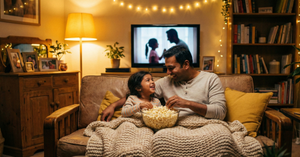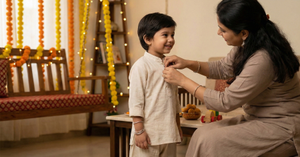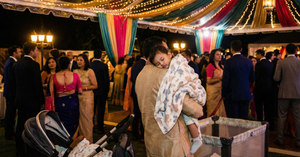“Why do we celebrate Diwali?”
If your kid has ever asked this question, you’re not alone. Kids love festivals, especially when there are lights, sweets, and fireworks. But behind all the sparkle lies a story that’s full of courage, love, and goodness.
So, let’s tell them the story that started it all. The story of Lord Rama and the reason Diwali shines so bright.
The Beginning: A Prince with a Big Heart
Once upon a time, in the beautiful kingdom of Ayodhya, there lived a kind and brave prince named Rama. He was loved by everyone for his honesty and courage. Rama was the eldest son of King Dasharatha, and one day, the king decided that Rama would be the next king.
But fate had a different plan. One of the king’s queens, Kaikeyi, wanted her own son, Bharata, to rule instead. She asked the king to send Rama away to the forest for 14 years. The king, bound by his promise, had to agree.
Even though Rama was deeply loved by the people, he accepted the decision calmly. He left the palace to live in the forest along with his wife, Sita, and his loyal brother, Lakshmana.
Life in the Forest: A Test of Strength and Love
In the peaceful forest, Rama, Sita, and Lakshmana lived a calm and happy life. They built a small hut and spent their days surrounded by trees, animals, and sunshine. But not everyone was happy about their peace.
One day, a demoness named Surpanakha saw Rama and wanted to marry him. But Rama politely said no; he loved only Sita. Angry, Surpanakha tried to harm Sita out of jealousy. To protect Sita, Lakshmana stepped in and cut off Surpanakha’s nose.
Humiliated, Surpanakha ran crying to her brother, Ravana, the powerful king of Lanka.
Enraged, Ravana decided to take revenge on Rama. He thought the best way to hurt Rama would be to take away Sita, whom Rama loved the most.
One day, Ravan came to their hut in disguise as a poor sage. He stood at the door and asked for food and water. Sita, being kind-hearted, stepped out to give him alms.
The moment she crossed the line drawn by Lakshmana for her safety (the Lakshman Rekha), Ravan revealed his true form. He lifted Sita into his flying chariot, the Pushpak Viman, and took her away to his kingdom, Lanka.
When Rama and Lakshmana returned and found Sita missing, they were heartbroken. But Rama didn’t lose hope. He promised to bring Sita back, no matter how far he had to go.
The Great Battle: Good vs Evil
Rama began his journey to rescue Sita. Along the way, he met Hanuman, the mighty monkey god, and Sugriva, the monkey king. They became his strongest allies.
Hanuman leapt across the ocean to reach Lanka and found Sita there, waiting faithfully for Rama. He gave her Rama’s ring to assure her that help was coming soon.
With the help of Hanuman and his army, Rama built a bridge to Lanka. A fierce battle took place between Rama’s army and Ravan’s powerful warriors. Finally, Rama defeated Ravan, ending his rule of pride and cruelty.
It was a victory of good over evil, light over darkness, and truth over lies.
The Return to Ayodhya: The First Diwali
After rescuing Sita, Rama, Sita, and Lakshmana returned to Ayodhya after 14 long years. The people were so happy that they lit rows of diyas (oil lamps) to welcome them home.
That night, the whole city glowed like a sea of stars. Laughter, music, and joy filled the air. That was the first Diwali, the festival of lights.
Since then, people celebrate Diwali every year to remember the victory of light over darkness and the power of goodness.
What Diwali Means Today
Today, we celebrate Diwali by cleaning our homes, making rangolis, lighting diyas, and praying to Goddess Lakshmi, the goddess of wealth and prosperity. Kids enjoy wearing new clothes, sharing sweets, and celebrating with their families.
But the real meaning of Diwali goes deeper. It reminds us to keep our hearts kind, our words truthful, and our minds full of light.
The Lesson Behind the Lights
When you explain Diwali to your kids, tell them it’s not just about lamps and crackers. It’s about what those lights mean.
- Light stands for hope and goodness.
- Clean homes mean clean hearts, free from anger or jealousy.
- Sharing sweets means spreading joy with everyone around us.
Every diya we light is like a tiny wish for peace, love, and happiness.
Conclusion
So, the next time your kid asks, “Why do we celebrate Diwali?” you can tell them this:
“Because long ago, Lord Rama came home after defeating Ravan. People lit lamps to celebrate his return. We still light them today to remind ourselves that no matter how dark things seem, light will always win.”
That’s the real meaning of Diwali: a story that began long ago but still shines bright in every heart and home.








Be the first one to comment on this story.